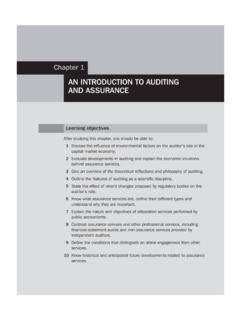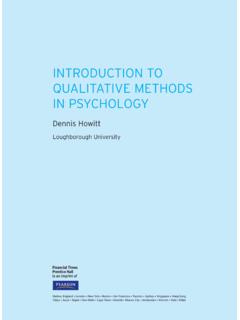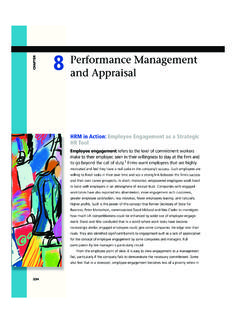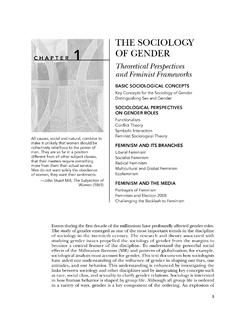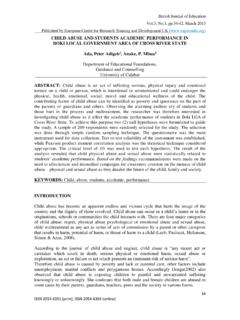Transcription of Part 1 INTRODUCTION TO LAW - Pearson HE UK
1 part 1 INTRODUCTION TO LAW1 The nature of law32 Law making123 Resolving disputes463 Chapter 1 The nature of lawLearning objectivesAfter studying this chapter you should understand the following main points: the nature of law; the ways in which the law may be classified, including the differencesbetween public and private law, civil and criminal law and common lawand equity; the development of English law including the emergence of the commonlaw and equity; the basic principles of legal liability, such as the distinction between civiland criminal law affects every aspect of our lives; it governs ourconduct from the cradle to the grave and its influenceeven extends from before our birth to after our live in a society which has developed a complexbody of rules to control the activities of its are laws which govern working conditions ( bylaying down minimum standards of health and safety),laws which regulate leisure pursuits ( by banningalcohol on coaches and trains travelling to footballmatches), and laws which control personal relationships( by prohibiting marriage between close relatives).
2 So, what is law and how is it different from otherkinds of rules? The law is a set of rules, enforceable by thecourts, which regulate the government of the state andgovern the relationship between the state and its citizensand between one citizen and another. As individuals weencounter many rules . The rules of a particular sport,such as the off-side rule in football, or the rules of a club,are designed to bring order to a particular activity. Otherkinds of rule may really be social conventions, such asnot speaking ill of the dead. In this case, the rule ismerely a reflection of what a community regards to beappropriate behaviour.
3 In neither situation would weexpect the rule to have the force of law and to be enforcedby the this book we are concerned with one specific areaof law: the rules which affect the business world. Weshall consider such matters as the requirements thatmust be observed to start a business venture, the rightsand duties which arise from business transactions andthe consequences of business failure. In order to under-stand the legal implications of business activities, it isfirst necessary to examine some basic features of ourEnglish legal system. It is important to remember thatEnglish law refers to the law as it applies to England andWales.
4 Scotland and Northern Ireland have their owndistinct legal of lawThere are various ways in which the law may beclassified; the most important are as follows:1 Public and private distinction between public and private law is illustrated in Figure (a)Public law. Public law is concerned with the relation-ship between the state and its citizens. This comprisesseveral specialist areas such as:(i)Constitutional law. Constitutional law is concerned withthe workings of the British constitution. It covers suchmatters as the position of the Crown, the compositionPart 1 INTRODUCTION to law4 Figure distinction between public and private lawand procedures of Parliament, the functioning of centraland local government, citizenship and the civil libertiesof individual citizens.
5 (ii)Administrative law. There has been a dramaticincrease in the activities of government during the lasthundred years. Schemes have been introduced to helpensure a minimum standard of living for agencies are involved, for example, in theprovision of a state retirement pension, income supportand child benefit. A large number of disputes arise fromthe administration of these schemes and a body of law,administrative law, has developed to deal with the complaints of individuals against the decisions of the administering agency.(iii)Criminal law. Certain kinds of wrongdoing posesuch a serious threat to the good order of society thatthey are considered crimes against the whole commu-nity.
6 The criminal law makes such anti-social behaviouran offence against the state and offenders are liable to punishment. The state accepts responsibility for thedetection, prosecution and punishment of offenders.(b)Private law. Private law is primarily concerned withthe rights and duties of individuals towards each state s involvement in this area of law is confined toproviding a civilised method of resolving the disputethat has arisen. Thus, the legal process is begun by theaggrieved citizen and not by the state. Private law is alsocalled civil law and is often contrasted with criminal and civil rules are generally dividedinto two categories: criminal and civil.
7 It is important tounderstand the nature of the division because there arefundamental differences in the purpose, procedures andterminology of each branch of law.(a)Criminal law. The criminal law is concerned withforbidding certain forms of wrongful conduct and pun-ishing those who engage in the prohibited acts. Criminalproceedings are normally brought in the name of theCrown and are called prosecutions. In 1985 responsibilityfor the process of prosecution passed from the police toa newly created independent Crown Prosecution Serviceunder the direction of the Director of Public Prosecu-tions (Prosecution of Offences Act 1985).
8 It should be noted that prosecutions may also be undertaken bybodies, such as the trading standards department of thelocal authority, and by private individuals, a storedetective prosecuting a shoplifter. In criminal casesyou have a prosecutorwho prosecutesa defendantinthe criminal courts. The consequences of being foundguilty are so serious that the standard of proof is higherthan in civil cases: the allegations of criminal conductmust be proved beyond a reasonable doubt. If the prosecution is successful, the defendant is found guilty (convicted)and may be punishedby the courts.
9 TheCriminal Justice Act 2003 sets out for the first time inlegislation the purposes of sentencing adult offenders,which are punishment, crime reduction, the reform andrehabilitation of offenders, and reparation. Punishmentsavailable to the court include imprisonment, fines, orcommunity orders such as an unpaid work the prosecution is unsuccessful, the defendant isfound not guilty (acquitted). A businessperson mayfind themselves in breach of the criminal law under suchenactments as the Companies Act 2006, the ConsumerProtection from Unfair Trading Regulations 2008 andthe Health and Safety at Work etc.
10 Act 1974.(b)Civil law. The civil law deals with the private rightsand obligations which arise between individuals. TheChapter 1 The nature of law5 Figure differences between criminal and civil lawpurpose of the action is to remedy the wrong that has been suffered. Enforcement of the civil law is theresponsibility of the individual who has been wronged;the state s role is to provide the procedure and the courtsnecessary to resolve the dispute. In civil proceedingsa claimantsues a defendantin the civil courts. Theclaimant will be successful if he can prove his case on the balance of probabilities, the evidence weighsmore in favour of the claimant than the defendant.

